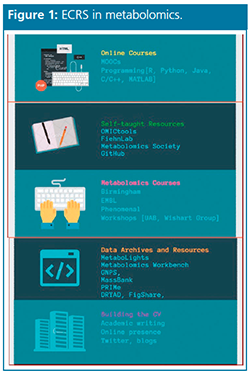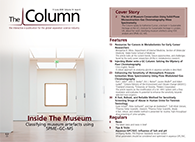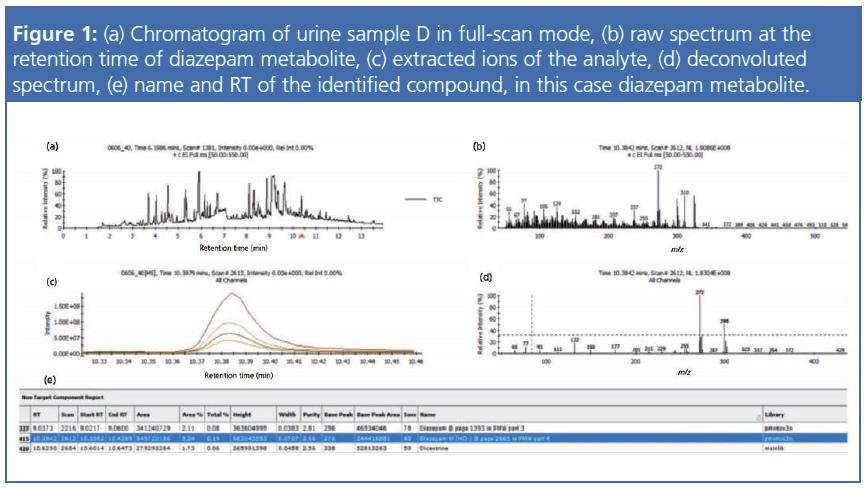Resources for Careers in Metabolomics for Early Career Researchers
Metabolomics, a word coined in 1998, is the study of small molecules (that is, organic chemicals with a molecular weight of 50–2000 Daltons) present in a given biological fluid, tissue, organ, organism, and environment at a given time. Using the power and high throughput of analytical platforms, such as mass spectrometry (MS) or nuclear magnetic resonance (NMR) spectroscopy, metabolomics promises to be a cornerstone in innovations and discoveries in the areas of medicine, agriculture, biomedical, space, and environment. Thus, science, technology, engineering, and mathematics (STEM) graduates and doctorates who interface with analytical chemistry need to prepare for the challenges of academia or industry as metabolomics research takes a centre stage in this big data era.
Photo Credit: tomertu/Shutterstock.com

Metabolomics, a word coined in 1998, is the study of small molecules (that is, organic chemicals with a molecular weight of 50–2000 Daltons) present in a given biological fluid, tissue, organ, organism, and environment at a given time. Using the power and high throughput of analytical platforms, such as mass spectrometry (MS) or nuclear magnetic resonance (NMR) spectroscopy, metabolomics promises to be a cornerstone in innovations and discoveries in the areas of medicine, agriculture, biomedical, space, and environment. Thus, science, technology, engineering, and mathematics (STEM) graduates and doctorates who interface with analytical chemistry need to prepare for the challenges of academia or industry as metabolomics research takes a centre stage in this big data era.
A recent market research study published by Crystal Market Research reveals that the metabolomics market is projected to be around $2.5 billion by 2025 (1). Early career researchers (ECRs), loosely defined as those who obtained their PhDs within the last 10 years (at times including PhD students, postdocs, and assistant professors), hold the key to future success in this area of research, and to drive the innovations in the present day. They form an important human resource who have the potential to contribute to the advances in technological innovations. With open science (OS), increased citations, media coverage, a rigorous and transparent peerâreview process, better archiving options, low or no cost options, data sharing (2), and open access (OA) (3) models of science and research becoming more popular, there is even more research touching even more lives. I point to some resources below that help in career development to enable a metabolomics or “omics” researcher to realize the avenues available to allow them to perform impactful research as a young investigator in academia or industry.
Resources in Career Development
Several societies, agencies, and publishers, for instance publishers like Public Library of Science (PLOS), eLife, and Accelerating Science and Publication in Biology (ASAPbio), promote ECR activities through blogs, travel awards, and building resource centres. Several on-line ECR award funding and resources are made available for ECRs themselves (3). More importantly, applying for these awards are more important than not getting the experience and one does not get an award without applying for one! The skill sets needed to explain science that does not need content expertise to capture a big picture implication of a “metabolomics” study outside of academia can be very demanding. No matter what the scope of the impact is, preparation to excel in one’s own field of research is important, and to this end, a diverse array of on-line resources is available to help researchers to develop skill sets, such as communication and leadership skills.
On-Line and Off-Line Courses: A command of data analysis and visualization warrants skill sets in programming and coding, which encompass learning several computer languages. Massive open on-line courses (free on-line courses) offered by the top universities and colleges in a wide range of subjects from programming in R to learning Python and MATLAB on-line are available and are less timeâintensive, selfâpaced, and helpful in crafting a career skill. The most popular ones are: Stanford Online (5), Coursera (6), Khan Academy (7), Data Camp (8), and Lynda.com (9) among others. The aboveâmentioned resources allow one to learn the “ABCs”-the basics of languages-to even advanced training such as tool or software development. More specifically, courses on deep learning, machine learning, neural networks, data science, big data, bioinformatics, data visualization, statistics with R, Python, and Java are deemed useful for data analysts.
The National Institutes of Health (NIH)’s Metabolomics Common Fund programme (https://commonfund.nih.gov/metabolomics/training) lists and points to an array of resources for metabolomics training. For more focused hands-on training in analytical techniques directed towards metabolomics research, excellent courses are available from West Coast Metabolomics Center (WCMC) and UC Davis on both the data and instrument side, such as those listed here, http://metabolomics.ucdavis.edu/courses-and-seminars/courses. The Metabolomics Workbench provides a lot of materials, resources, and links to metabolomics training through their portal: http://www.metabolomicsworkbench.org/training/online.php. One prominent course is Metabolomics in Medicine (http://metabolomicsinmedicine.org/) supported by the NIH Common Fund Metabolomics Award developed by Martin Kohlmeier at the University of North Carolina, USA. The Southeast Center for Integrated Metabolomics (SECIM) at the University of Florida, Gainesville, USA, (https://ctsi-secim.sites.medinfo.ufl.edu/) lists a host of informative videos, tutorials, and lectures as well.

Metabolomics-Specific Self-Taught Resources: For metabolomics-specific training in resources such as those mirroring advancements in analytical and theoretical methods, on-line resources such as metabolomic tools catalogues are available: OMICtools (10,11), Fiehn Lab resources (12), metabolomics society’s resource pages (12), Metabolomics Tools Wiki catalogue (13), and software repositories such as Comprehensive R Archive Network (CRAN) (14), Bioconductor (15), and GitHub (16). In addition, several recent efforts have listed all tools, resources, software, and databases that have been introduced in 2015–2017 (17,18). Using the above resources one can venture into the ever-expanding universe of software, databases, resources, and tools to download, go through the manual, install, and play along for their utility in metabolomic dataset analysis-either for real world data or the trial data that come with the tools.
Metabolomics Courses: There are several courses and workshops available across the world at many institutions and universities and those known as centres for excellence in metabolomics research, training, and education. For instance, the Birmingham University’s Metabolomics Data Processing and Data Analysis is a free on-line course organized by the Birmingham Metabolomics Training Center (19) that is very popular and the only registered MOOC in metabolomics (20) to date. Similarly, the European Bioinformatics Institute (EBI), European Molecular Biology Laboratory (EMBL) organizes several courses in metabolomics (21) all year round, as does Metabolomics Workflows (22) and PhenoMeNal’s accessing metabolomics workflows in Galaxy (23). In the USA, courses are organized by the University of Alabama (UAB) (24) and in Canada by the Wishart group at The Metabolomics Innovation Centre (TMIC) (25). Some of these involve bring-your-own-data (BYOD) sessions as well, thus allowing the participants to bring their data and address some of the challenges and workflows on-site. In Europe for instance, the European Metabolomics Training Coordination Group (EmTraG) (http://www.emtrag.eu/) has been launched to implement a metabolomics training strategy and it collaborates closely with ELIXIR (and the ELIXIR Training Platform) at a European level and the Metabolomics Society at an international level.
Tools, Software, and Databases: For increased impact, sharing of the metabolomics datasets is vital to allow peers to gain confidence in the datasets generated by researchers for meta-analysis among others. These public archives are growing and are developed keeping in mind the metabolomics community; they are available at UK-based MetaboLights (26) and USA-based MetabolomicsWorkbench (27), the two most prominent resources for archiving. In addition, open access MassBank (28) and PRIMe (Platform for RIKEN Metabolomics), RIKEN, Japan (29) are other resources where data retrieval is possible. Sharing of large datasets at the DRYAD (30,31) and FigShare (32,33) has provided free resources for obtaining largeâscale metabolomics datasets. More recently, the Global Natural Products Social Molecular Networking (34), an open-access knowledge base for community-wide organization and sharing of raw, processed, or identified MS/MS-based metabolomics data (35) hosted at University of California San Diego (UCSD) Center for Computational Mass Spectrometry (CCMS) (36), has gained immense popularity. In addition, for mass spectrometry imaging data, MetaSpace (37,38) is a go-to database. Moreover, The Konstanz Information Miner (KNIME) (39, 40) -based workflows that incorporate steps from chromatographic pre-processing to statistical analysis and visualization of “omics”âscale data are starting to be incorporated into metabolomics pipelines. During the analysis of data, GitHub also welcomes fruitful discussions and helps reproducibility efforts across the globe.
Beyond innovative, impactful, and cuttingâedge scientific accomplishments, to build that near perfect curriculum vitae (CV), outstanding scientists in the early stages of their careers must apply for a lot of competitive awards and fellowships dedicated to ECRs by many scientific societies and organizations. Moreover, opportunities for mentoring an undergraduate or a graduate student, judging a school science fair, or the opportunity to speak at a local school should all be accommodated into one’s busy schedule to be able to add that extra edge to the CV. This serves multiple purposes: (i) polishing the science communication and public engagement skills, (ii) taking the science out of the confines of the laboratory walls to the masses, and (iii) honing the mentoring and oratory skills that would be necessary while writing manuscripts and presenting in meetings, symposia, workshops, and conferences. Readers are suggested to consult Blank et al., who stress the need for modernizing the PhD and postdoc training across more institutions and more disciplines (41).
A lot of popular resources in metabolomics can be easily tracked on social media platforms such as Twitter with hashtags #metabolomics in addition to those made available to ECRs using #ecr, #ecrchat, #phdchat, and #acwri among others. An onâline presence through blogs and social media such as Twitter, Facebook, and LinkedIn allow networking with peers, potential hirers, and future colleagues. For instance, the International Metabolomics Society hosted forum (http://www.metabolomics-forum.com/) allows a platform for exchange of ideas, troubleshooting, and resolving issues ranging from analytical and data science challenges in metabolomics to career development and growth.
Activities from metabolomics societies from specific countries provide resources to get ECRs trained and involved, for example, the Scottish Metabolomics Network (http://scottishmetabolomics.net/), Australia New Zealand Metabolomics Network (www.anzmn.org), RFMF (Réseau Francophone de Métabolomique et Fluxomique) (http://www.rfmf.fr/), Korea Metabolomics Society (KoMetS) (www.komets.or.kr), and Swiss Metabolomics Society (http://www.swiss-metabolomics.ch/) among others.
MetaboNEWS serves as the sole platform to showcase the ongoing activities of the early career member network (EMN) committee of the International Metabolomics Society, such as organization of monthly webinars and workshops in the annual metabolomics conference among others. This year’s annual gala metabolomics event, the 14th International Conference of the Metabolomics Society, is scheduled to be held in Seattle, Washington, USA, 24–28 June 2018 http://metabolomics2018.org/. Attending these meetings are immensely useful for ECRs to showcase their work to the attendees in the society, as well as networking for future collaborations and job opportunities.
Conclusions
By choosing a research and career path in metabolomics, the opportunities as an ECR abound, but they need to be grabbed in a timely fashion with polished and ready skill sets, supportive mentorship, and readiness to hop onto opportunities. Moreover, the research efforts of ECRs are what is going to shape the future innovations and applications of mass spectrometry and spectroscopy-based metabolomics research efforts.
Conflicts of Interest
The author declares no conflicts of interest.
References
- Metabolomics Market by Technique and Application - Global Industry Analysis and Forecast to 2025: http://www.crystalmarketresearch.com/press-releases-details/global-metabolomics-market Accessed on 20 November 2017
- E.C. McKiernan, P.E. Bourne, C.T. Brown, S. Buck, A. Kenall, J. Lin, D. McDougall, B.A. Nosek, K. Ram, C.K. Soderberg, and J.R. Spies, Elife5, 16800 (2016).
- B.C. Björk and D. Solomon, BMC medicine10(1), 73 (2012).
- ECR Funding sources: https://docs.google.com/spreadsheets/d/1H1aj--VUYr7eMFk_T7x0Oh985LqbyyscXg2wAAevDnU/edit#gid=0 Accessed on 20 November 2017
- Stanford Online: thttp://online.stanford.edu/ Accessed on 20 November 2017
- Coursera: https://www.coursera.org/ Accessed on 20 November 2017
- Khan Academy: https://www.khanacademy.org/ Accessed on 20 November 2017
- DataCamp: https://www.datacamp.com/ Accessed on 20 November 2017
- Lynda.com: https://www.lynda.com/ Accessed on 20 November 2017
- V.J. Henry, A.E. Bandrowski, A.S. Pepin, B.J. Gonzalez, and A. Desfeux, Database (Oxford) 14, 2014 (2014).
- OMICTools: http://omictools.com/ Accessed on 20 November 2017
- Metabolomics Society, Metabolomic Databases: http://metabolomicssociety.org/resources/metabolomics-databases Accessed on 20 November 2017
- Metabolomics Tools Wiki: https://raspicer.github.io/MetabolomicsTools/ Accessed on 11 June 2018
- CRAN: https://cran.r-project.org/web/packages/available_packages_by_name.html Accessed on 20 November 2017
- Bioconductor: https://www.bioconductor.org/ Accessed on 20 November 2017
- GitHub: https://github.com/ Accessed on 20 November 2017
- B.B. Misra and J.J. der Hooft, Electrophoresis37(1), 86–110 (2016).
- B.B. Misra, J.F. Fahrmann, and D. Grapov, Electrophoresis38(18) 2257–2274 (2017).
- Metabolomics Data Processing and Data Analysis: http://www.birmingham.ac.uk/facilities/metabolomics-training-centre/courses/Metabolomics-Data-Processing-and-Data-Analysis.aspx Accessed on 20 November 2017
- Metabolomics: Understanding Metabolism in the 21st Century (FutureLearn): https://www.mooc-list.com/tags/metabolomics Accessed on 20 November 2017
- EMBO Practical Course on Metabolomics Bioinformatics for Life Scientists: http://www.ebi.ac.uk/training/events/2018/embo-practical-course-metabolomics-bioinformatics-life-scientists-4 Accessed on 20 November 2017
- Metabolomics Workflows: https://www.ebi.ac.uk/training/events/2017/metabolomics-workflows Accessed on 20 November 2017
- PhenoMeNal: accessing metabolomics workflows in Galaxy: http://www.ebi.ac.uk/training/online/course/phenomenal-accessing-metabolomics-workflows-galaxy?platform=hootsuite Accessed on 20 November 2017
- UAB Metabolomics: http://www.uab.edu/proteomics/metabolomics/workshop.php
- Informatics and Statistics for Metabolomics (2017): https://bioinformatics.ca/workshops/2017/informatics-and-statistics-metabolomics-2017 Accessed on 20 November 2017
- N.S. Kale, K. Haug, P. Conesa, K. Jayseelan, P. Moreno, P. Rocca-Serra, V.C. Nainala, R.A. Spicer, M. Williams, X. Li, and R.M. Salek, Current Protocols in Bioinformatics14–13 (2016).
- M. Sud, E. Fahy, D. Cotter, K. Azam, I. Vadivelu, C. Burant, A. Edison, O. Fiehn, R. Higashi, K.S. Nair, and S. Sumner, Nucleic acids research 1042 (2015).
- MassBank, http://www.massbank.jp/?lang=en Accessed on 20 November 2017
- PRIMe: http://prime.psc.riken.jp/ Accessed on 20 November 2017
- H. White, S. Carrier, A. Thompson, J. Greenberg, and R. Scherle, In Dublin Core Conference 157–162 (2008).
- Dryad Digital Repository – Dryad: http://datadryad.org/ Accessed on 20 November 2017
- M. Thelwall and K. Kousha, Online Information Review40(3), 333–346 (2016).
- Figshare: https://figshare.com/ Accessed on 20 November 2017
- GNPS: http://gnps.ucsd.edu Accessed on 20 November 2017
- MassIVE: https://gnps.ucsd.edu/ProteoSAFe/index.jsp Accessed on 20 November 2017
- M. Wang, J.J. Carver, V.V. Phelan, L.M. Sanchez, N. Garg, Y. Peng, D.D. Nguyen, J. Watrous, C.A. Kapono, T. Luzzatto-Knaan, and C. Porto, Nature Biotechnology34, 828–837 (2016).
- Metaspace2020: http://annotate.metaspace2020.eu/#/datasets Accessed on 20 November 2017
- A. Palmer, P. Phapale, I. Chernyavsky, R. Lavigne, D. Fay, A. Tarasov, V. Kovalev, J. Fuchser, S. Nikolenko, C. Pineau, and M. Becker, Nature Methods14(1), 57–60 (2016).
- KNIME: https://www.knime.com/ Accessed on 20 November 2017
- M.R. Berthold, N. Cebron, F. Dill, T.R. Gabriel, T. Kötter, T. Meinl, P. Ohl, K. Thiel, and B. Wiswedel, AcM SIGKDD explorations Newsletter 11(1), 26–31 (2009).
- R. Blank, R.J. Daniels, G. Gilliland, A. Gutmann, S. Hawgood, F.A. Hrabowski, M.E. Pollack, V. Price, L.R. Reif, and M.S. Schlissel, Science358(6369), 1388–1389 (2017).
Biswapriya B. Misra is currently an Assistant Professor at the Center for Precision Medicine, School of Medicine, Wake Forest Baptist Medical Center, Winston-Salem, North Carolina, USA, with efforts in metabolomics and multiâomics towards understanding human diseases of metabolic origin, that is, diabetes, obesity, and cardiovascular diseases. Graduating from IIT Kharagpur, India, he did multiple postdocs at the Center for Chemical Biology in Malaysia (Rubber tree genomics), University of Florida (Single cell-type “canola” metabolomics), and Texas Biomedical Research Institute (Non-human primate model multi “omics”), acquiring skill sets in multiple “omics” and high dimensional datasets. Biswapriya is interested in driving mass-spectrometry–based “omics” (metabolomics and proteomics) for integration with sequencing-based efforts. @BiswapriyaMisra and 0000-0003-2589-6539
E-mail:bbmisraccb@gmail.com

Discovering the Hidden Plastic in Garden Compost with Pyr-GC–MS
May 12th 2025An Australian study used pyrolysis coupled to gas chromatography-mass spectrometry (Pyr-GC–MS) to analyze the presence of plastic polymers in commercial and homemade composts. LCGC International spoke to Simran Kaur—a PhD candidate at the Queensland Alliance for Environmental Health Sciences (QAEHS) at The University of Queensland in Woolloongabba, Australia—to find out more about her team’s findings.

.png&w=3840&q=75)

.png&w=3840&q=75)



.png&w=3840&q=75)



.png&w=3840&q=75)












